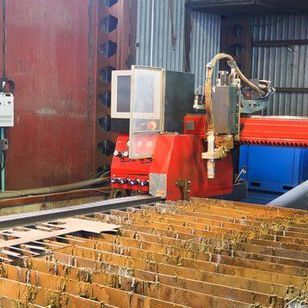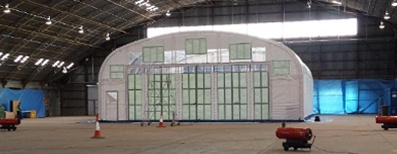DuroPure™ for Lean Manufacturing Finishing
As the manufacturing sector in North America slowly restores itself from the effects of a global recession, the conventional methods of producing and moving parts through the various manufacturing steps are being reconsidered in view of the principles of the lean manufacturing concept.
Applying lean manufacturing principles to product finishing processes
Optimizing a company’s lean manufacturing potential requires innovation and a focus on minimizing waste and creating value for customers. Lean manufacturing concentrates on optimizing the flow of products and services throughout an operation thus eliminating areas of waste.
Product finishing processes such as grinding, sanding, coating and painting often create bottlenecks in the manufacturing process.
Duroair Technologies prides itself on offering customers market-leading air filtration solutions and enclosure systems that break new ground in clean air technology. Duroair’s solution-based approach of non-vented air filtration, retractable enclosure systems and climate-controlled cleanrooms is uniquely designed to maximize product flow in most finishing operations.
The evolution of manufacturing: from craft to lean
Prior to the start of the 20th century, manufacturing was a craft and all products were custom made by highly skilled and versatile trades people. In the early 1900s, Henry Ford introduced mass production and changed manufacturing forever. The Ford System had three key elements: a conveyor to move work to the worker, a division of labour to separate the manufacturing process into simple, repetitive tasks that could be performed by a low skill work force and an integrated supply chain to bring parts and materials to the assembly line.
In the late 1940s, the Toyota Production System evolved from the Ford manufacturing system. Managers and workers learned to question the need for every work sequence, every item of work in process inventory, and any amount of time that people, material and machines were idle. As a result, management and employees learned to identify and eliminate waste, increasing both production and quality. The terms “continuous process improvement” and “lean manufacturing” appeared in the late 1980s as the North American label for the Toyota Production System.
Key components of lean manufacturing include:
Seven Wastes Waste is anything other than the absolute minimum resources of material, machines, and labour required to add value as defined by the customer. Waste is anything that the customer will not pay for or does not need. The seven wastes of manufacturing are:
- Waste of overproduction - producing more than needed
- Waste of waiting - operator or machine idle time because the process is unbalanced
- Waste of transportation - any movement of material that does not directly support value added operations
- Waste of processing - any operation that does not add value to a product
- Waste of inventory - any inventory in excess of that required for manufacturing product
- Waste of motion – any movement of people or machines which does not add value
- Waste of defects – all repairs to product to fulfill customer requirements
Cells The proper placement of machines and equipment is essential in achieving an operational objective. Benefits of good cell layout are reduced inventory, a balanced cell, less walking time and an improved work area.
One Piece Flow One-piece-flow is based on the concept of minimizing work-in-process by having operators throughout the process focus on making only one part at a time before starting the next part. That is, make-one, move-one. One-piece-flow dramatically reduces handling and transportation and provides immediate feedback to any overlooked defect.
Any lean manufacturing plant layout should remain flexible. As a result of continuous improvement, it may be required to rearrange the equipment to achieve the new standard. To make this possible, most lean experts recommended putting equipment on casters for easy movement.
For product finishing processes such as grinding, sanding, coating and painting manufacturers rely heavily on large assets that inhibit material flow through the plant. These “monuments” as they are commonly referred to are often permanent structures that require air handling including exhausting to the outside environment.
Mechanical Engineering principles dictate that when volumes of air are exhausted from a space, these volumes have to be replaced with equal volumes from outside that space. The solutions that provide this air replacement are commonly called “Make-Up Air Units.” Usually located on rooftops, they provide supply air for general, process, and combustion exhaust. This “make-up air” commonly needs to be treated (heated, cooled, de-humidified, etc.) through configurations in the units prior to entering the space. In addition, a duct system for air transportation and a supporting electrical system are required in the “make-up air” infrastructure.
“Make-up air” systems require design-build features in the construction phase as well as energy to operate and ongoing service and maintenance.
The lean philosophy has methods for dealing with situations like this, such as sourcing modular equipment or starting the flow process at a downstream work center. In reality, these added challenges force many manufacturers to shy away from lean for finishing applications with continued waste as a consequence.
Non-Vented Air Recycling Filtration Solutions
The best equipment for a lean layout can be easily disconnected from utilities and moved as production needs dictate changes in cell design. Duroair Technologies evolved from the realization that there were limited ventilation options that addressed lean requirements in product finishing applications.
Duroair Technologies’ unique solution, DuroPure™, is a market leading, portable indoor air filtration and recycling unit that completely recycles and recirculates air without exhausting contaminants to the outside environment. This advanced air purification system is made possible through a patented, high-efficiency, six-stage filtration process to capture 100% of airborne particulates, as well as gases and vapours, resulting in thoroughly cleaned air that is well within OSHA’s allowable standards. DuroPure™ removes the need for outside venting, air make-up and its associated costs.
DuroPure™: The finishing solution for lean manufacturing
DuroPure™ is equipped to perform a wide range of product finishing processes. With no venting requirements, users have access to a mobile, purified work environment ideal for dust control, welding, painting and other cleanroom applications that require the elimination of airborne contaminants and chemicals or the need for climate control.
In addition, the modular designed DuroRoom™ Enclosure retracts to 20% of the extended length, allowing for maximum use of existing floor space during intermittent use.
DuroPure systems are available from 13,500 CFM to 80,000 CFM and beyond, and can be equipped with casters to establish point-of-use product finishing capabilities – ensuring that solutions are where they need to be to optimize material flow.
Conclusion:
Designing the layout of a plant floor using lean principles can be a difficult task. One of the biggest challenges confronting plant engineers is deciding which processes can be adapted for the lean layout and which processes must be performed using traditional methods.
Until now, product finishing processes mostly occupied the latter category but with the arrival of non-vented air recycling filtration solutions, manufacturers now have the opportunity to successfully address the product finishing points of waste and fully optimize the flow of products.
Sources: http://www.slideshare.net/johncleveland/lean-manufacturing-2753881 http://catalyticovens.com/mdfpowdercoat/files/2013/02/PowderCoating_Nov2010.pdf http://www.vtcomposites.com/Vermont_Composites_Capabilities/Lean_Manufacturing.aspx http://leanmanufacturingtools.org/121/waste-of-overprocessing-causes-symptoms-examples-and-solutions/ http://www.intellifinishing.com/assets/files/IntelliFinishingMM0912forwebcopy.pdf http://www.artoflean.com/files/Basic_TPS_Handbook_v1.pdf http://citeseerx.ist.psu.edu/viewdoc/download?doi=10.1.1.201.6147&rep=rep1&type=pdf http://www.lean-alliance.com/en/images/pdf/la_lean_survey.pdf http://www.assemblymag.com/articles/89823-lean-plant-layout



